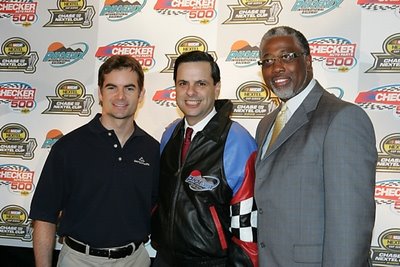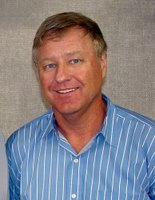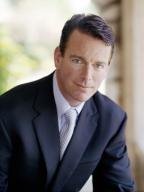 One thing you can always count on from politicians: They will always be politicians. Two days after opposing Phoenix International Raceway's true wishes by voting "yes" for a downtown Champ Car race, Phoenix Mayor Phil Gordon (center) and Councilman Michael Johnson (right) were all-too-happy to show-up at a PIR promotional event for a smiling photo-op with Jeff Gordon. The four-time NASCAR champion visited the city briefly last Thursday to meet the 24 winners of a Georgia-Pacific/Bashas/Pepsi/PIR sweepstakes. Jeff also did a quick round of media interviews to advance the Nov. 12 Checker Auto Parts 500k at PIR.
One thing you can always count on from politicians: They will always be politicians. Two days after opposing Phoenix International Raceway's true wishes by voting "yes" for a downtown Champ Car race, Phoenix Mayor Phil Gordon (center) and Councilman Michael Johnson (right) were all-too-happy to show-up at a PIR promotional event for a smiling photo-op with Jeff Gordon. The four-time NASCAR champion visited the city briefly last Thursday to meet the 24 winners of a Georgia-Pacific/Bashas/Pepsi/PIR sweepstakes. Jeff also did a quick round of media interviews to advance the Nov. 12 Checker Auto Parts 500k at PIR.----------------------------------------------------------------------------------
Never mind controversial reports about alleged cheating in the garage area. There's a cover-up going on at almost every NASCAR race.
Since all things in the modern media world seem to require a label, let's call it Towelgate.
No need to call Woodward and Bernstein, though, because I know you know what I mean. This trend of somebody draping a sponsor towel over a driver's shoulder is so obvious -- and looks so absolutely ridiculous -- that it's impossible not to notice. If certain people don't get smart in a hurry, this may well cost some team owner money, and it already makes the old-time "Hat Dance" looks like sophisticated sports marketing.
When Kevin Harvick won the first Chase race, at New Hampshire, Richard Childress Racing sponsors Goodwrench, Sylvania and Snap-on lost their TNT TV time because a red-and-white Coca-Cola towel covered-over their logos on Harvick's uniform. Nextel Cup towels were also being passed around. When Tony Stewart was interviewed, Coke and Goodyear lost out on exposure, because the white-and-blue Old Spice towel was put over Stewart's shoulder. After last Saturday's Kansas Busch Series event, TNT viewers didn't see the Chevrolet, Outdoor Channel and Coke logos on Stewart's suit, again because of the OS towel. Sunday, on NBC, was a New Hampshire replay for winner Stewart's backers.
 I am asking those involved in this absurb process to show me where it is written in their signed contracts that they have the right to take away another company's ID. That is a paid-for benefit of sponsorship. I understand drivers have personal corporate deals, and series sponsors have certain privileges, but I'll say this: If I were the CEO or marketing VP or racing program manager whose company logo wasn't visible on TV because somebody decided to engage in a different sort of identity theft, I'd politely but carefully explain to the driver and owner that I PAID to have that logo in that space and if they didn't respect my support enough to protect my interests, well, it's been fun but I'll find an owner and driver willing to do so. Period.
I am asking those involved in this absurb process to show me where it is written in their signed contracts that they have the right to take away another company's ID. That is a paid-for benefit of sponsorship. I understand drivers have personal corporate deals, and series sponsors have certain privileges, but I'll say this: If I were the CEO or marketing VP or racing program manager whose company logo wasn't visible on TV because somebody decided to engage in a different sort of identity theft, I'd politely but carefully explain to the driver and owner that I PAID to have that logo in that space and if they didn't respect my support enough to protect my interests, well, it's been fun but I'll find an owner and driver willing to do so. Period.One reason the mainstream media didn't take auto racing seriously in the early decades was that silly victory-lane tradition known as "The Hat Dance." As the winner was doing his television interview, sponsor and accessory company reps would pile into the loosely-controlled area, pushing their way toward the driver. One-after-another, they'd yank-off whatever cap he was wearing, and jam-on a lid with a different logo. It wasn't unusual for there to be three-four hat changes in 30-45 seconds. Non-motoring broadcasters and writers would use that as evidence to support their stick-and-ball bias, opining that racers were a bunch of uncouth, advertising-obsessed amateurs.
Speedways and sanctioning organizations eventually became aware of how this spectacle looked on TV and enacted some rules. Flamboyant Bill Broderick, PR director for Union/Unocal 76, gained his own cult following as "The Hat Man" for running the show in NASCAR winner's circles for over 25 years. NASCAR, and other sanctions, later put their own people in charge but it remained a work in progress -- evidenced a few years ago by non-Coke sponsored drivers knocking POWERade bottles (NASCAR's official sports drink) off their car's roof. Mike Helton finally put the brakes on that embarrassment.
I have a bit of experience with this issue. I attended CART's 1985 Winter Meetings where sponsors -- led by STP's respected motorsports VP Ralph Salvino -- voted unanimously in favor of asking CART to ban the use of floral wreaths in victory lane. As Salvino told CART Chairman John Frasco, "I paid for those (uniform) patches. I want them to be seen!" I was disappointed to see the return of wreaths this season at some IRL and Rolex Series events. When POWERade became NHRA's title patron in 2002, some bright light decided to start tossing that towel over each winning driver's shoulder. I was working with Darrell Russell, and quietly counseled the late Top Fuel star that when this happened, he should casually remove it. Darrell did so in such an easy-going way no one was the wiser. I also privately raised the issue with a Coca-Cola official, who agreed the brand's logo towels weren't creating much extra ID, and certainly not enough to justify alienating other sponsors.
I'm sure they are useful on the golf course and to Pittsburgh Steelers' fans, but at the speedways, these things truly are The Terrible Towels.
 It was no surprise when the announcement came last week that August Busch IV (below, photo courtesy of PR NewsWire) will become president and CEO of Anheuser-Busch on
It was no surprise when the announcement came last week that August Busch IV (below, photo courtesy of PR NewsWire) will become president and CEO of Anheuser-Busch on  Dec. 1. Busch, 42, has been on this track virtually his entire professional life. It's important for racers to note this news, however, because A-B is widely respected as one of the world's savviest and most sophisticated sports marketers. We all know of Budweiser's headline sponsorship of Dale Earnhardt Jr., plus the Bud King NHRA Top Fuel team of Kenny and Brandon Bernstein, and that pairing will reach an incredible 30 consecutive years under the current contract. Don't be distracted by recent media reports that the Busch brand might conclude its 25-year support of the NASCAR Busch Series. (I played a small role in the transition from the 1981-82 Budweiser Late Model Sportsman Series to the Busch Series in 1983 while working for A-B's agency.) NASCAR (and ISC) leaders have carefully respected A-B and accommodated its executives over the years and it's truly been a win-win relationship. Too bad the Indianapolis Motor Speedway didn't do the same the last time August IV attended the Indy 500 to watch a car run under primary Bud backing.
Dec. 1. Busch, 42, has been on this track virtually his entire professional life. It's important for racers to note this news, however, because A-B is widely respected as one of the world's savviest and most sophisticated sports marketers. We all know of Budweiser's headline sponsorship of Dale Earnhardt Jr., plus the Bud King NHRA Top Fuel team of Kenny and Brandon Bernstein, and that pairing will reach an incredible 30 consecutive years under the current contract. Don't be distracted by recent media reports that the Busch brand might conclude its 25-year support of the NASCAR Busch Series. (I played a small role in the transition from the 1981-82 Budweiser Late Model Sportsman Series to the Busch Series in 1983 while working for A-B's agency.) NASCAR (and ISC) leaders have carefully respected A-B and accommodated its executives over the years and it's truly been a win-win relationship. Too bad the Indianapolis Motor Speedway didn't do the same the last time August IV attended the Indy 500 to watch a car run under primary Bud backing.[ more Thursday . . . ]